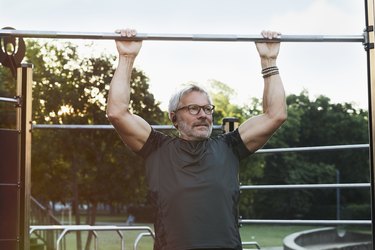
When most people work out, they think about the effects of physical activity on their muscles or heart health. But exercise also has benefits for your skeletal system, including increased bone density, improved joint mobility and increased synovial fluid circulation.
But the kind of exercise you do matters. Your skeletal system responds to weight-bearing exercise more than non-weight-bearing exercise. Weight-bearing exercises force your skeletal system to work against gravity and include weightlifting, jogging, climbing stairs, tennis and dancing. For comparison, non-weight-bearing exercises would include swimming and cycling.
Video of the Day
Video of the Day
To reap the long-term effects of exercise on your bones, the U.S. Department of Health and Human Services recommends that adults do at least 150 to 300 minutes of moderate-intensity aerobic exercise and at least two full-body muscle-strengthening workouts each week.
Tip
Short-term effects of exercise on the skeletal system include the start of bone remodeling and strengthening. Over time, bone strength and density increase, circulation of blood and synovial fluid improves, and your strength and range of motion increase.
Maintaining Bone Density
As the body ages, bone density naturally decreases. In severe cases it leads to osteoporosis, resulting in increased risk of fractures and falls from weakness.
Osteoblasts — cells that deliver calcium to your bones — slow down and transport less calcium from your blood to your bones during inactivity, but exercise has the opposite effect and increases osteoblastic activity. Thus, exercise increases bone strength and mineral density.
Exercise also helps to slow the process of bone degeneration and causes remodeling of the bones, a process which repairs small damages and strengthens the bones to adapt to the demands of exercise, per an October 2017 article in Biogernontology.
The remodeling occurs as a result of stress on the bone from muscle contraction and impact during weight-bearing exercises, such as running, stair climbing and jumping rope, according to a May 2018 article in the International Journal of Environmental Research and Public Health.
Increasing Joint Range of Movement
Joints connect bones in your body and consist of tissues like cartilage, ligaments and menisci. Regular exercise also improves the health and mobility of your joints, while a sedentary lifestyle can lead to joint degeneration and rigidity.
Cartilage must be stressed by exercise and movement to remain functional, according to a 2017 article in Clinical Calcium. In addition, exercise increases blood and synovial fluid circulation in your joints. Synovial fluid is the substance that lubricates your joints. This helps not only healthy joints but can help relieve pain and add stability to joints with osteoarthritis.
Reducing Risk of Injury
The muscles are an important component of the musculoskeletal system. In addition to the benefits to your bones and joints, exercise increases your muscular strength, endurance and flexibility, while also improving your coordination and balance.
All of these components allow you to perform tasks more easily and decrease your risk of injury and falls, as your muscles adapt better to sudden obstacles and unstable surfaces. Strong muscles also help to support and protect your joints, decreasing the risk of injury, says Harvard Health Publishing.
Related Reading
Exercise Risks and Considerations
Exercise offers many benefits for your bones, but it also brings the risk of harm and injury — especially if you exercise too much.
Exercising too much may trigger negative responses from your skeletal system. You can lose bone density if you exercise too much and don't consume enough calcium and vitamin D. People who menstruate and exercise too much may not experience menstrual periods, indicating low estrogen levels and increasing the risk of brittle bones and osteoporosis.
Listen to your body. If you experience pain, stop the exercise and consult your doctor. In some cases, joints and tendons may be damaged from overuse of performing too many of a single exercise. Switch up your routine and perform a variety of exercises. Support your body during exercise by maintaining a healthy diet, staying hydrated and prioritizing adequate sleep and recovery.
Avoid injury by performing all exercises with correct form to avoid wrenching a joint or pulling a muscle. Don't lift weights that are too heavy for your fitness level, and increase the intensity of your workouts slowly over time to allow your body to adapt and strengthen without injury. If necessary, perform modified versions of exercises to build up your strength and protect your joints.
- Harvard Health Publishing: "Easy Ways to Adapt Exercises When You Have Arthritis"
- NIH Osteoporosis and Related Bone Diseases: "Exercise for Your Bone Health"
- Len Kravitz, PhD: "Exploring the Mysteries of Exercise"
- MedlinePlus: "Calcium"
- U.S. Department of Health and Human Services: "Physical Activity Guidelines for Americans"
- Biogernontology: "Exercise and bone health across the lifespan"
- International Journal of Environmental Research and Public Health: "Exercise Early and Often: Effects of Physical Activity and Exercise on Women’s Bone Health"
- Clinical Calcium: "Effects of Exercise on Joints"